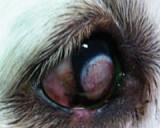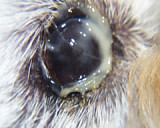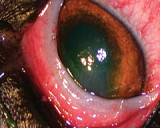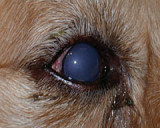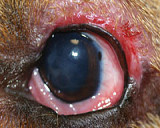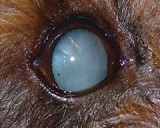ALWAYS consider breed predisposition. Many eye cases in dogs developed because of inbreeding. Just assume that any German Shepherd with an eye problem you see has pannus, Bassets are predisposed to glaucoma, young Bichon Frise often develop cataracts, just assume that all brachycephalics have corneal disease.
 Use a Transilluminator - a bright focal light.
Use a Transilluminator - a bright focal light.
This is a very useful piece of equipment. It can be used to test the PLRs, and to examine the anterior segment. Re-examine your patient with the lights turned down. This may help to highlight the lesion being examined. In some cases we diagnose PRA (progressive retinal atrophy) with the focal light—seeing the marked tapetal hyper-reflectivity doing the PLR tests, and considering the history of night blindness and the breed predisposition.
Use Magnification.
There are many eye conditions that are better seen with magnification. Use magnification to check the anterior segment both before and after dilating the pupil. The retrollumination from a dilated pupil may make a magnified corneal exam more revealing. Please feel free to contact us about types of magnification that are useful.
Schirmer Tear Test.
Do a STT in all cases of ocular discharge and in all cases of conjunctival and or corneal disease. A STT is useful even if there is excess watery discharge. Wipe away the excess tears, do the STT. If the STT > 20 suspect irritation as a cause of the epiphora. If the STT is around normal ie 15 mm wetting/minute look for decreased tear drainage as a cause of the epiphora. Many cases of conjunctivitis can be caused by or may cause dry eye. Chronic conjunctivitis can lead to dry eye. Early diagnosis and treatment of dry eye generally achieves the best long term results.

Conjunctivitis
Always look for a predisposing cause for conjunctivitis cases. Dry eye is a common predisposing factor. Also consider eyelid conformation, deep set eyes, third eyelid problems eg cartilage eversion, and tear duct problems. Use the combined antibiotic/cortisone preparations for 5 days only. If more therapy is needed reconsider your diagnosis.
Chronic Conjunctivitis in dogs is usually due to chronic allergies. In these cases topical cortisones such as Prednefrin Forte or Maxidex will be more effective than less potent ointments. Most chronic conjunctivitis cases in cats are secondary to Herpes virus or Chlamydia and need a prolonged course of doxycycline (this is usually 5mg/kg BID for 21 days).
Corneal Ulcers.
Whenever you diagnose a corneal ulcer, always consider what has caused for the ulcer. Missed underlying causes include dry eye, entropion, ectopic cilia, facial nerve paralysis, trigeminal nerve paralysis.
▪ We treat all our ulcers with oral doxycycline and systemic NSAIDs.
▪ Reserve the potent antibiotics such as gentamicin and the fluoroquinolones for confirmed melting corneas. We do not use these antibiotics for prophylaxis.
▪ Never grid indolent ulcers in cats* - these are usually viral and gridding leads to sequestration.

Cherry Eye Surgery requires meticulous technique with correct instrumentation. Small dogs do well with the mucosal pocket (Morgan) techniques. Large breed dogs can be a considerable challenge, their third eyelids are often too wide and may have concurrent third eyelid cartilage eversion. Referral for Cherry eye surgery in larger dogs should be considered. Entropion in dogs is often associated with overly long lower eyelids. For most cases in dogs we rollout the lower lid and also shorten the lower eyelid with a V section. Recurrence rates are extremely low with the combined technique.
Entropion in cats.
We are seeing more and more entropion in cats. Many of these cats will develop secondary corneal sequestration. For entropion surgery in cats we rollout the lower lid and also close the lateral canthus to reduce the risk of recurrence in the future. Removal of corneal sequestration is indicated at the time of the entropion repair.
